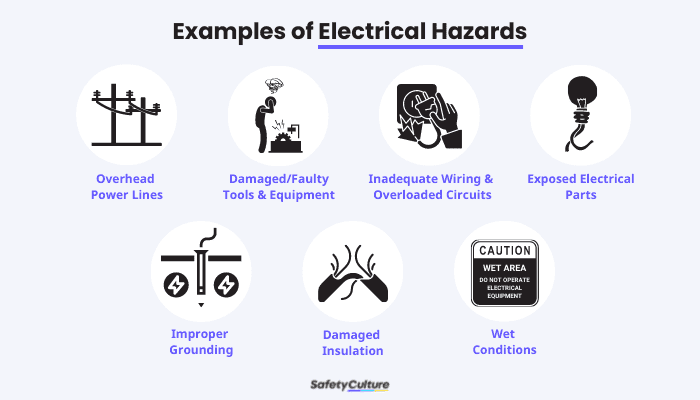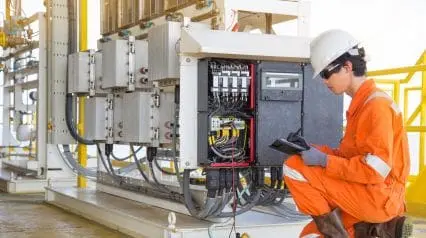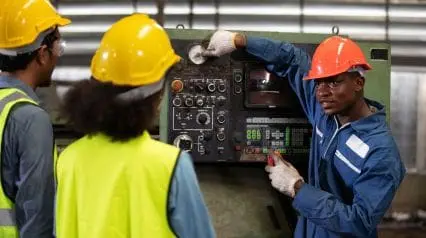What are Electrical Hazards?
Electrical hazards refer to the potential dangers and risks that are associated with electrical systems. These hazards can cause dangers such as burns, electrocution, arc flash, electric shock, and other serious injuries. In extreme cases, they can even lead to fires or explosions, posing a threat to life, property, and the overall safety of a place and its occupants.
Why It’s Important to Know About These Hazards
Working around electricity can be very safe on the job site when workers properly identify and control hazards. But, inadequate training, lack of experience, and failure to recognize potential hazards could result in electric shock or death.
The construction industry is most in danger from electrical hazards, accounting for 52% of all electrical fatalities in the US workplace. Most of these incidents and fatalities were caused by direct worker contact with overhead power lines and contact with machines, tools, and hand-carried metallic objects. So how do we protect ourselves against these dangers?
One of the best ways to protect yourself against these dangers is through awareness. Knowing the potential risks associated with electricity allows you to take precautions to prevent electrical accidents and fatalities. Having this knowledge can also help you spot the signs of electrical hazards immediately for prompt action, thereby contributing to the overall safety of the workplace.
Causes of Electrical Hazards
Electrical hazards, while dangerous, can be prevented when you’re aware of the factors that contribute to them. Here’s a list of the most common causes of electrical hazards to watch out for:
- Insufficient insulation – Over time, electrical insulation can deteriorate due to wear and tear, rodents, or exposure to moisture. This degradation can lead to exposed wires and increase the risk of electric shock or short circuits.
- Circuit breaker failure – If the circuit breaker fails to trip during an overload, it loses its protective functioning, further increasing the risk of electrical hazards.
- Damaged electrical appliances – Loose connections, frayed wires, or cracked insulation can result in electrical malfunctions.
- Improper use of extension cords – Practices like daisy chaining and overloading can cause overheating and ignite electrical fires.
- Inadequate maintenance – Failing to regularly inspect electrical systems, ignoring warning signs, or bypassing safety procedures can trigger severe electrical hazards over time.
Improve your EHS Management
Cultivate a safe working environment and streamline compliance with our EHS solutions.
Explore nowElectrical Hazards Examples
Electrocution is one of the most common hazards across construction sites according to OSHA. Identifying electrical hazards can help raise awareness of the risks, their severity, and how they can harm workers.
In this section, learn about common electrical hazards in the workplace and electrical safety tips to prevent them:
- Overhead power lines
- Damaged tools and equipment
- Inadequate wiring and overloaded circuits
- Exposed electrical parts
- Improper grounding
- Damaged insulation
- Wet conditions

Examples of Electrical Hazards
Overhead Power Lines
Overhead powered and energized electrical lines have high voltages which can cause major burns and electrocution to workers. Remember to maintain a minimum distance of 10 feet from overhead power lines and nearby equipment. Conduct site surveys to ensure that nothing is stored under overhead power lines.
In addition, safety barriers and signs must be installed to warn nearby non-electrical workers of the hazards present in the area.
Damaged Tools and Equipment
Exposure to damaged electrical tools and equipment can be very dangerous. Do not fix anything unless you are qualified to do so. Thoroughly check for cracks, cuts, or abrasions on cables, wires, and cords. In case of any defects, have them repaired or replaced.
Aside from this, Lock Out Tag Out (LOTO) procedures should be performed at all times before commencing electrical maintenance and repairs. LOTO procedures are there to protect all workers on a worksite.
Inadequate Wiring and Overloaded Circuits
Using wires of inappropriate size for the current can cause overheating and electrical fires to occur. To prevent this, use the correct wire suitable for the operation and the electrical load to work on. Use the correct extension cord designed for heavy-duty use.
Make sure to not overload an outlet and use proper circuit breakers. Perform regular fire risk assessments to identify areas at risk of bad wiring and circuits.
Exposed Electrical Parts
Examples of exposed electrical parts include temporary lighting, open power distribution units, and detached insulation parts on electrical cords. These hazards can cause potential shocks and burns. Secure these items with proper guarding mechanisms and always check for any exposed parts to be repaired immediately.
Improper Grounding
The most common OSHA electrical violation is the improper grounding of equipment. Proper grounding can eliminate unwanted voltage and reduce the risk of electrocution. Never remove the metallic ground pin as it is responsible for returning unwanted voltage to the ground.
Damaged Insulation
Defective or inadequate insulation is a hazard. Be aware of damaged insulation and report it immediately. Turn off all power sources before replacing damaged insulation and never attempt to cover them with electrical tape.
Wet Conditions
Never operate electrical equipment in wet locations. Water greatly increases the risk of electrocution especially if the equipment has damaged insulation. Have a qualified electrician inspect electrical equipment that has gotten wet before energizing it.
Preventing Hazards Through Electrical Inspections
Electrical inspections are an essential preventive measure to avoid electrical hazards in the workplace. This procedure helps detect and address potential hazards, reducing the risk of electrical injuries and contributing to a safer working environment. Failure to conduct these inspections regularly can also lead to accidents caused by electric shock or even death.
So how do these inspections aid in preventing electrical hazards? Here’s a quick overview to help you get started:
- Assessing the condition of electrical equipment – During an electrical inspection, a property’s electrical equipment undergoes quality and safety checks to ensure that they are in working condition before being operated.
- Detecting electrical hazards – Regular electrical inspections allow electricians to identify faulty wiring, damaged cords, or malfunctioning equipment and carry out the necessary repairs or replacements.
- Ensuring compliance with safety codes – These inspections are conducted by electrical servicing companies to make sure that a property follows electrical safety laws and regulations.
- Evaluating electrical safety procedures – Electrical inspections provide an overall assessment of the worksite, training provided, and equipment used. These results allow you to identify and bridge any gaps in safety procedures.
- Recommending corrective actions – After completing the inspection, inspectors provide recommendations on areas for improvement based on the identified risks and noncompliances. These can range from repairs and replacements to upgrades and safety training.
Create Your Own Electrical Hazard Safety Checklist
Eliminate manual tasks and streamline your operations.
Get started for FREESet the Tone for Safety with Electrical Hazards Safety Training
Electrical safety training is a must for personal safety, accident prevention, and regulatory compliance. It equips workers with the necessary skills to minimize risks and safeguard themselves against electrical hazards in various workplace settings.
Don’t let your team’s electrical hazards safety training turn into another tedious activity that they just want to get over with. With the help of training courses on the SafetyCulture (formerly iAuditor) platform, you can give them an engaging training experience while making sure that they learn everything they need to work safely and effectively.
And here’s the best part: most of these Training courses are designed to be editable! Feel free to add your own content or branding to make the training look and sound just like you.
FAQs About Electrical Hazards
Engineers, electricians, and overhead line workers, both contractors and subcontractors are at the top of the list of professionals who are most exposed to electrical hazards. Common tasks that put these workers at risk include electrical installation and repairs, testing of fixtures and equipment, and inspection and maintenance activities.
People who are indirectly working with electricity like office workers are also exposed to electrical hazards.
According to the National Electrical Code, electrical hazard areas are specific places or environments with an increased risk of electrical hazards. These hazardous locations typically have conditions or equipment that pose potential dangers to workers, such as:
- Chemical plants
- Oil refineries
- Mines
- Gas stations
- Laboratories
Electrical equipment should be checked regularly to make sure that they are working properly and are safe to use. Testing intervals, however, may vary depending on various factors such as the type of equipment, its intended use, the manufacturer’s recommendations, and the working environment they are utilized or exposed to.
For instance, some equipment may require quarterly or biannual check-ups. OSHA also recommends that all electrical equipment be inspected at least once every year.
Faulty electrical equipment can put individuals at risk if they’re not found and resolved swiftly. Here are a few signs that could warn you if your electrical equipment is defective:
- Visibly damaged wiring
- Scorching or discoloration around outlets or switches
- Flickering or dimming lights
- Buzzing or crackling sounds
- Persistent burning odors
- Hot outlets or switches
- Frequent tripping of circuit breakers




